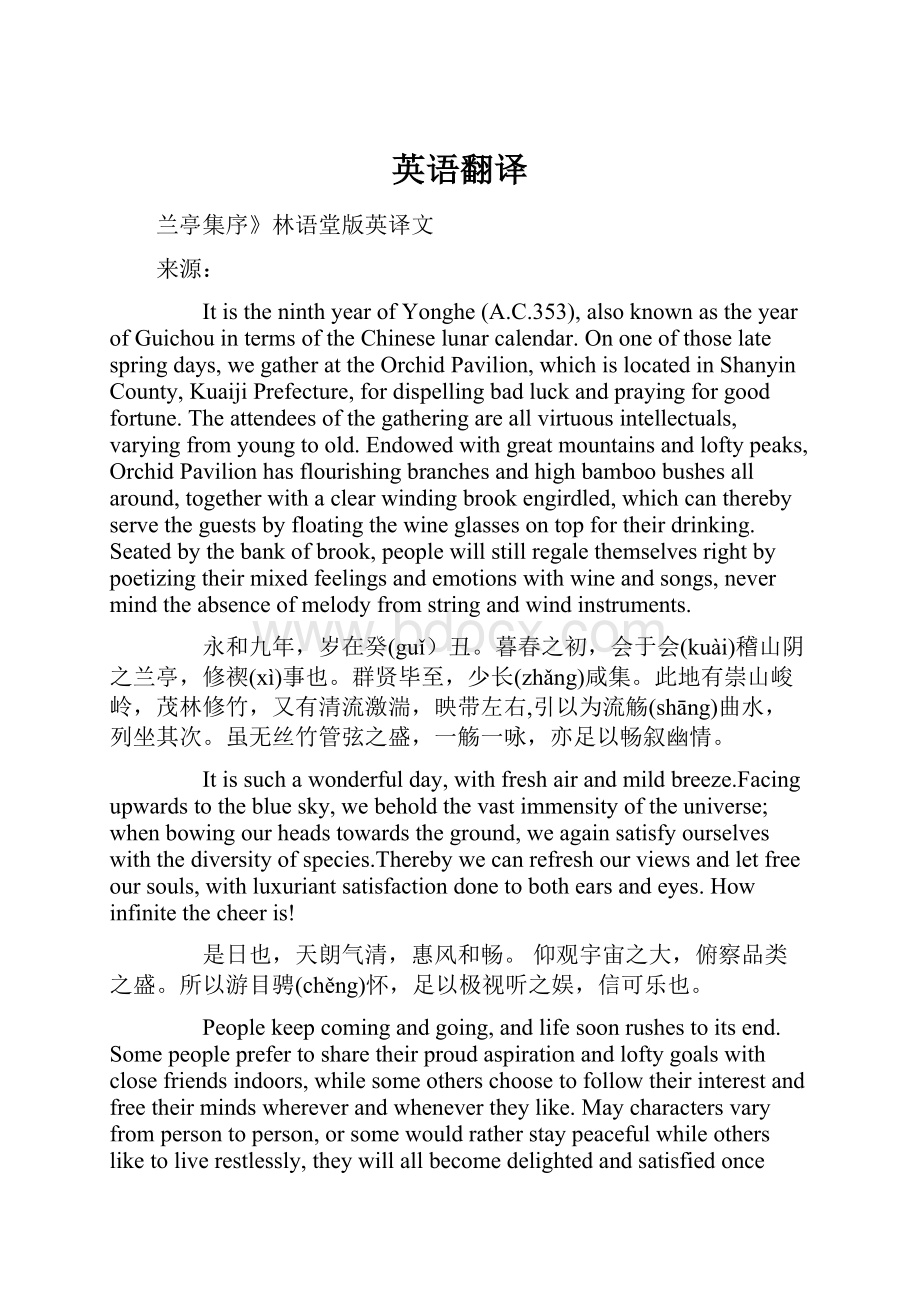英语翻译.docx
《英语翻译.docx》由会员分享,可在线阅读,更多相关《英语翻译.docx(12页珍藏版)》请在冰豆网上搜索。

英语翻译
兰亭集序》林语堂版英译文
来源:
ItistheninthyearofYonghe(A.C.353),alsoknownastheyearofGuichouintermsoftheChineselunarcalendar.Ononeofthoselatespringdays,wegatherattheOrchidPavilion,whichislocatedinShanyinCounty,KuaijiPrefecture,fordispellingbadluckandprayingforgoodfortune.Theattendeesofthegatheringareallvirtuousintellectuals,varyingfromyoungtoold.Endowedwithgreatmountainsandloftypeaks,OrchidPavilionhasflourishingbranchesandhighbamboobushesallaround,togetherwithaclearwindingbrookengirdled,whichcantherebyservetheguestsbyfloatingthewineglassesontopfortheirdrinking.Seatedbythebankofbrook,peoplewillstillregalethemselvesrightbypoetizingtheirmixedfeelingsandemotionswithwineandsongs,nevermindtheabsenceofmelodyfromstringandwindinstruments.
永和九年,岁在癸(guǐ)丑。
暮春之初,会于会(kuài)稽山阴之兰亭,修禊(xì)事也。
群贤毕至,少长(zhǎng)咸集。
此地有崇山峻岭,茂林修竹,又有清流激湍,映带左右,引以为流觞(shāng)曲水,列坐其次。
虽无丝竹管弦之盛,一觞一咏,亦足以畅叙幽情。
Itissuchawonderfulday,withfreshairandmildbreeze.Facingupwardstothebluesky,webeholdthevastimmensityoftheuniverse;whenbowingourheadstowardstheground,weagainsatisfyourselveswiththediversityofspecies.Therebywecanrefreshourviewsandletfreeoursouls,withluxuriantsatisfactiondonetobothearsandeyes.Howinfinitethecheeris!
是日也,天朗气清,惠风和畅。
仰观宇宙之大,俯察品类之盛。
所以游目骋(chěng)怀,足以极视听之娱,信可乐也。
Peoplekeepcomingandgoing,andlifesoonrushestoitsend.Somepeopleprefertosharetheirproudaspirationandloftygoalswithclosefriendsindoors,whilesomeotherschoosetofollowtheirinterestandfreetheirmindswhereverandwhenevertheylike.Maycharactersvaryfrompersontoperson,orsomewouldratherstaypeacefulwhileothersliketoliverestlessly,theywillallbecomedelightedandsatisfiedoncetheymeetsomethingpleasant,socheerfulthattheygetunawareoftheirimminentoldage.However,whentheygettiredoftheiroldfanciesthatthey’vealreadyexperienced,andsentimentcorrespondinglyaccompaniesthechangeofsituation,allsortsofcomplicatedfeelingswillwellupintheheart,too.Isn’titthought-provokingthatthehappinessweusedtoenjoypassesbywithoutleavingasingletrace,letalonethatthelengthoflifeissubjecttothefate,anddeathisinevitableforanybodyintheend?
Justassomeancientmanonceputit,“Deathalsodeservesourattention,likewhatlifedoes.”,sohowcanwerestrainourselvesfromgrieving?
夫(fú)人之相与,俯仰一世。
或取诸怀抱,悟言一室之内;或因寄所托,放浪形骸之外。
虽趣(qǔ)舍万殊,静躁不同,当其欣于所遇,暂得于己,快然自足,不知老之将至;及其所之既倦,情随事迁,感慨系之矣。
向之所欣,俯仰之间,已为陈迹,犹不能不以之兴怀,况修短随化,终期于尽!
古人云:
“死生亦大矣”,岂不痛哉!
EverytimeIponderaboutthereasonswhyourpredecessorswouldproduceworkswithsuchinenarrableemotions,Ifindthereseemsomesimilaritiesbetweenourminds.YetIcannothelplamentingtheirliterarymasterpieceswhileIamstrugglingfortheverycauseinmyinnermostworld.NowIcometorealizethatithasbeenridiculousformetoequatedeathwithlife,longlifewithshortlife.Thedescendentsviewusjustthewaywelookatourpredecessors,andhowwoefulitis!
HenceIwritedownallthenamesoftheattendeesandputtheirpoetryintorecord.Conditionsmaygowiththechangesoftime,butpeople’semotionsshallstaythesame.Ibelievethefollowingreaderswillstillhavemuchtomediateaboutlifeanddeathwhenappreciatingthispoetryanthology.
每览昔人兴感之由,若合一契,未尝不临文嗟悼(jiēdào),不能喻之于怀。
固知一死生为虚诞,齐彭殇(shāng)为妄作。
后之视今,亦犹今之视昔,悲夫!
故列叙时人,录其所述,虽世殊事异,所以兴怀,其致一也。
后之览者,亦将有感于斯文。
林语堂译《桃花源记》
来源:
桃花源记
陶渊明
晋太元中,武陵人捕鱼为业,缘溪行,忘路之远近。
忽逢桃花林,夹岸数百步,中无杂树,芳草鲜美,落英缤纷;渔人甚异之。
复前行,欲穷其林。
林尽水源,便得一山。
山有小口,仿佛若有光,便舍船,从口入。
初极狭,才通人;复行数十步,豁然开朗。
土地平旷,屋舍俨然。
有良田美池,桑竹之属,阡陌交通,鸡犬相闻。
其中往来种作,男女衣着,悉如外人;黄发垂髫,并怡然自乐。
见渔人,乃大惊,问所从来;具答之。
便要还家,设酒、杀鸡、作食。
村中闻有此人,咸来问讯。
自云:
先世避秦时乱,率妻子邑人来此绝境,不复出焉;遂与外人间隔。
问今是何世?
乃不知有汉,无论魏、晋!
此人一一为具言所闻,皆叹惋。
余人各复延至其家,皆出酒食,停数日,辞去。
此中人语云:
“不足为外人道。
”
既出,得其船,便扶向路,处处志之。
及郡下,诣太守,说如此。
太守即遣人随其往,寻向所志,遂迷不复得路。
南阳刘子骥,高尚士也,闻之,欣然规往,未果,寻病终。
后遂无问津者。
ThePeachColony
(translatedbyLinYutang林语堂)
DuringthereignofTaiyuanofChin,therewasafishermanofWuling.Onedayhewaswalkingalongabank.Afterhavinggoneacertaindistance,hesuddenlycameuponapeachgrovewhichextendedalongthebankforaboutahundredyards.Henoticedwithsurprisethatthegrovehadamagiceffect,sosingularlyfreefromtheusualminglingofbrushwood,whilethebeautifullygrassygroundwascoveredwithitsrosepetals.Hewentfurthertoexplore,andwhenhecametotheendofthegrove,hesawaspringwhichcamefromacaveinthehill,Havingnoticedthatthereseemedtobeaweaklightinthecave,hetieduphisboatanddecidedtogoinandexplore.Atfirsttheopeningwasverynarrow,barelywideenoughforonepersontogoin.Afteradozensteps,itopenedintoafloodoflight.Hesawbeforehiseyesawide,levelvalley,withhousesandfieldsandfarms.Therewerebamboosandmulberries;farmerswereworkinganddogsandchickenswererunningabout.Thedressesofthemenandwomenwerelikethoseoftheoutsideworld,andtheoldmenandchildrenappearedveryhappyandcontented.Theyweregreatlyastonishedtoseethefishermanandaskedhimwherehehadcomefrom.Thefishermantoldthemandwasinvitedtotheirhomes,wherewinewasservedandchickenwaskilledfordinnertoentertainhim.Thevillagershearingofhiscomingallcametoseehimandtotalk.TheysaidthattheirancestorshadcomehereasrefugeestoescapefromthetyrannyofTsinShih-huang(builderofGreatWall)somesixhundredyearsago,andtheyhadneverleftit.Theywerethuscompletelycutofffromtheworld,andaskedwhatwastherulingdynastynow.TheyhadnotevenheardoftheHanDynasty(twocenturiesbeforetotwocenturiesafterChrist),nottospeakoftheWei(thirdcenturyA.D.)andtheChin(thirdandfourthcenturies).Thefishermantoldthem,whichtheyheardwithgreatamazement.Manyoftheothervillagersthenbegantoinvitehimtotheirhomesbyturnandfeedhimdinnerandwine.Afterafewdays,hetookleaveofthemandleft.Thevillagersbeggedhimnottotellthepeopleoutsideabouttheircolony.
Themanfoundhisboatandcameback,markingwithsignstheroutehehadfollowed.Hewenttothemagistrate’sofficeandtoldthemagistrateaboutit.Thelattersentsomeonetogowithhimandfindtheplace.Theylookedforthesignsbutgotlostandcouldneverfinditagain.LiuTsechiofNanyangwasagreatidealist.Heheardofthisstory,andplannedtogoandfindit,butwastakenillanddiedbeforehecouldfulfillhiswish.Sincethen,noonehasgoneinsearchofthisplace.
厘清英汉差异,翻译游刃有余
来源:
翻译第一步主要是对英语原文的准确理解,在于准确把握每个单词的含义、每一层英语语法修饰关系;第二步要把理解准确的英语翻译成通顺、符合表达习惯的汉语。
翻译第一步主要是对英语原文的准确理解,在于准确把握每个单词的含义、每一层英语语法修饰关系;第二步要把理解准确的英语翻译成通顺、符合表达习惯的汉语。
每一位考生都会有这样的体会:
一个英语句子,似乎已经理解其意思了,但动手译成汉语时,却不知如何表达,或者汉语译文充满了“英语腔”。
出现这种情况,就是由英汉思维表达上的差别造成的。
翻译的过程不仅是语言形式的转换,还是处理英汉差异进行思维转换的过程,这就要求在汉译表达时,要进行英汉语序调整。
下面通过真题讲解如何处理常见的英汉差异,并提出相应的翻译技巧,如:
定语从句的翻译,被动语态的翻译,转换动词等。
1.英语定语多后置,汉语定语多前置
英语定语中,除了形容词作定语修饰名词时前置,大多数短语和句子作定语时基本是后置。
而与此相反,汉语中,定语都要置于被修饰名词的前面。
定语位置反映了英汉语言的一个重大差别。
一般来说,英语是“中心词+修饰语”的语言(head-firstlanguage);汉语则是“修饰语+中心词”的语言,即中心词后置的语言(head-lastlanguage)。
考生就应该遵循这个规律,在英译汉时,理解了英语定语结构后,用汉语的定语表达习惯表达出来。
每年英译汉5个句子中至少含有一个定语从句,2003年的试题中甚至有4个定语从句。
考生必须利用英汉定语差异把握定语从句的翻译技巧。
1.1前置法
我们知道,英语中的定语从句是在所修饰词的后面,但在把英语翻译成汉语时,可以直接把定语从句译成“……的”的定语短语,放置于被修饰的名词之前,这就是定语前置法。
Eg.Ittendstoignore,andthuseventuallytoeliminate,manyelementsinthelandcommunitythatlackcommercialvalue,butthatareessentialtoitshealthyfunctioning.
解析:
首先,该句由but连接两个并列that引导的定语从句,修饰manyelements“许多因素”。
其次,inthelandcommunity修饰manyelements,可直译为“土地群落中的很多因素”,但是“土地群落”用专业术语表达应该是“陆地生物群落”,这时,elements译为“因素”不恰当,而是指陆生群落中的“物种”。
最后,这个定语从句的意义和结构都较为简单,可用前置法组合成为“陆生群落中的很多缺乏商业价值但是对其健康机制至关重要的物种”。
译文:
这种保护体系往往会忽视,并因此最终消灭很多缺乏商业价值的但对其健康机制至关重要的物种。
1.2后置法
定语从句较为复杂时,如果运用定语前置法,把定语从句译成“……的”,就过于冗长,意义较为繁杂或容易引起歧义、表达不清,这时可用后置法。
把定语从句单独翻译成一个句子,放置于原来它所修饰的词的后面,关系代词可以译成先行词,或者与先行词相应的代词。
有以下三种处理方式:
(1)重复先行词
Eg.Thesecond,byJoshuaGreenberg,takesamoreempiricalapproachtouniversality,identifyingtraits(particularlyinwordorder)sharedbymanylanguages,whichareconsideredtorepresentbiasesthatresultfromcognitiveconstraints.
解析:
首先,which的先行词是traits,“特点,特征”。
干扰词是manylanguages,排除它是因为sharedbymanylanguages是过去分词短语作定语,修饰前面的traits,说明which前面的中心词是traits。
其次,谓语动词areconsideredto(被认为)在翻译时可以转化为主动的“人们认为”。
最后,that引导的定语从句的先行词是biases,该定语从句比较简单,可采用前置法,修饰“偏见”。
本题考查考生定语从句的翻译技巧。
本句带有两个较长的定语从句,不能两个都译成“……的”结构。
本句可以重复which所指的先行词“这些特征”,并把that引导的定语从句采用前置法放到前面修饰中心语,即“人们认为这些特征代表了由认知制约所产生的偏见”。
译文:
作出又一贡献的是乔舒亚•格林伯格,他运用了更为鲜明的经验主义方法来研究这种普遍性,鉴别出多种语言的共同特征(特别是在词序上的特征),而人们认为这些特征代表了由认知制约所产生的偏见。
(2)代词指代先行词
Eg.Whorfcametobelieveinasortoflinguisticdeterminismwhich,initsstrongestform,statesthatlanguageimprisonsthemind,andthatthegrammaticalpatternsinalanguagecanproducefar-reachingconsequencesforthecultureofasociety.
解析:
which,initsstrongestform,states……是which引导的定语从句。
首先,initsstrongestform是插入结构,代词its指代主句中的linguisticdeterminism(语言决定论),可以用汉语的特指“其”来代替,理解为“以其极端形式”,插入语修饰整个定语从句,可以放在定语从句之前。
其次,which的先行词也是linguisticdeterminism,谓语动词states“认为,宣称”后接两个并列宾语从句,这里可以用代词“其”来翻译关系词which,处理成一个独立的句子“其极端说法是:
……”。
译文:
沃尔夫进而相信某种类似语言决定论的观点,其极端说法是:
语言禁锢思维,语言的语法结构能对一个社会的文化产生深远的影响。
(3)省略关系词
如果把定语从句翻译在先行词后面,在保证句子“通顺、完整”的前提下,有时可以不用重复先行词。
Eg.Theyarethepossessionsoftheautonomous(self-governing)manoftraditionaltheory,andtheyareessentialtopracticesinwhichapersonisheldresponsibleforhisconductandgivencreditforhisachievements.(2002年真题英译汉第64题)
解析:
inwhichapersonisheldresponsibleforhisconductandgivencreditforhisachievements是which引导的定语从句。
首先,该定语从句有两个并列谓语部分,结构比较复杂,根据后置法
(1)重复先行词可以直接把这个定语从句组合在先行词后面。
其次,which的先行词是practices,介词in与先行词practices构成固定搭配,inwhich就相当于